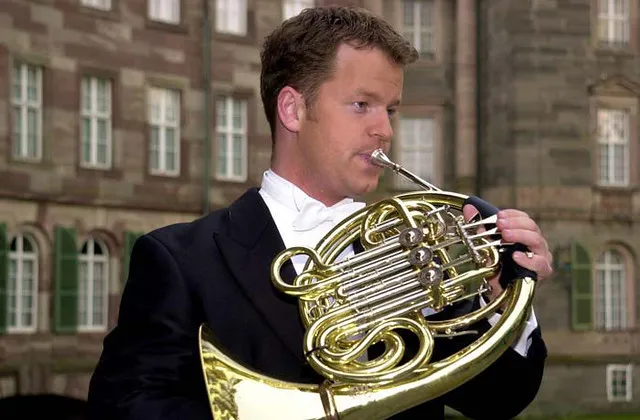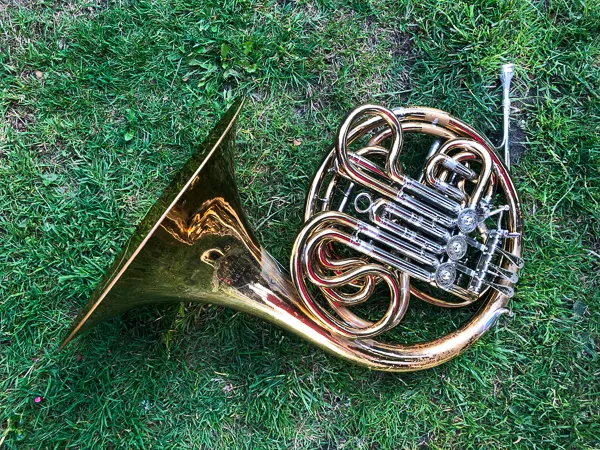In public perception, it may seem as though the french horn is just an instrument used by band geeks or to accent the brass section of large orchestras. Most aren’t aware of the rich and grandiose sound of the french horn being present in a number of contemporary hits from The Beatles’ melancholy but uptempo “For No One” to The Monkees’ equally somber “Shades of Gray”.
By learning the way a french horn functions and how it produces sound, not to mention why the way it’s built creates that deep timbre out of a relatively small instrument, we can develop a new appreciation for what has been dubbed by many as “the soul of the orchestra”.
Brass instruments are unlike any other family of instruments in their history and the unique way they get such a powerful sound that has permeated nearly every genre of music throughout time. So let’s start by talking about how, as a whole, these amazing instruments produce sound.

How Do Brass Instruments Produce Sound?
Most simply put, a brass instrument is a conduit that takes the air pumped directly into it by the performers’ lungs and gives it a unique vibration through a series of valves and tubes before spitting it out the “bell” (That wide opening at the end of every brass instrument).
The performer can affect the pitch and quality of the sound purely through the shape of their mouth and the amount of air pushed through their tightly-pressed lips. The other way the pitch can be affected is by manipulating the various levers and slides standard on most brass instruments.
The length of the tubes the air travels through determines how high or low the pitch becomes. This is why the tuba, the largest of the brass instruments, is famous for its gargantuan low sound. While the smallest brass instruments like the trumpet and the cornet are better known for their place in the high end of orchestral and jazz compositions.
The french horn doesn’t appear to be that large, so it’s deep sound comes as a surprise to many first time listeners. In reality the tubing of a french horn can be up to 13 feet long! It loops and coils into its signature spiral shape that makes it convenient to hold in the lap of any experienced or aspiring horn player.
Nevertheless, the amount of tubing crammed into an instrument that, at first glance, seems similar to or smaller than it’s fellow trombone or flugelhorn, actually packs far more complexity within that creates a sound unlike any other instrument.
The French Horn
The early ancestors of the modern brass french horn began to appear in the 1600s, and were used on hunts. Hunting horns were common practice at that time in Europe.
They signaled other members of the hunting party when an animal was located and celebrated when the hunt was successfully completed. An early form of the french horn, known today as the “natural horn”, was commonly played on horseback in that era.
The earliest french horns were shaped similarly to the modern french horn, but lacked the valves that allow modern horns to play chromatically (That is, in every key). Those valves weren’t invented until the early-19th century and didn’t become common practice until the mid to late-19th century. This is when the french horn as we know it today began circulation in Europe.
Before the invention and popularization of valves within brass horns, horns could only play in a set harmonic series — meaning they were limited in the amount of notes they could play. This resulted in different horns being made in varying lengths for performers to switch between when playing different keys.
How Sound Is Produced In A French Horn?
Airflow in the french horn, as in all other brass instruments, is produced in the mouthpiece. Many who are new to or unfamiliar with french horn believe simply blowing into the end of the instrument will produce it’s iconic sound.
The reality is that the player’s lips need to be positioned in a very specific way, with their breath coming out in highly trained intervals, to create the vibrations necessary to make the instrument sing.
The lungs act as the backbone of all of the sound produced. They provide the air pressure which can be adjusted to change the pitch of the vibration without ever needing to push any of the valves.
For new players, training your lips and lungs will be the most frustrating but necessary part of the process. With practice it becomes muscle memory and a natural thing your body will be able to reproduce with ease every time you pick the instrument up.
At the start, though, it will be lots of hours of attempting to hold your lungs and lips in a specific way that you may find difficult to recreate on the occasions you get it right.
The valves
Additionally, when you press down on one of the valves, the air flow has new access to the tubes in the horn.

In some cases air may be allowed to access new tubing on the horn, which in turn makes the total length of the tubing longer and ultimately lowers the pitch of the instrument. In other cases, pressing down a valve may cut off access to a portion of the tubing, which makes the total length of the tubing shorter and ultimately raises the pitch of the instrument.
By pressing the valves down in different combinations, many different tubing lengths can be achieved. The full western scale can be played.
When you pair the various fingerings of the valves with the different speeds/pressures of your lips as you play through the mouthpiece, you can play many octaves with a French Horn!
Developments in The French Horn
Even with the introduction of valves opening up the brass section to the world of chromaticism, french horn players still struggled to reach their full potential.
The most talented horn players struggled to hit the highest range of the single horn instrument as a result of the build of the instrument making accuracy tricky.
Prior to the last years of the 19th century, the solution to this was french horn players swapping between two different french horns, one called the F horn (For lower pitches) and one called the B♭ horn (For higher pitches), depending on which range they needed to focus on in a particular piece.
This was still an inconvenient solution, however, as the result remained that french horn players were limited in their range to whichever type of horn they had in their hands. This was until 1897 when a man named Ed Kruspe invented the double horn, a french horn that combined the F and B♭ horns into the frame of a single instrument.
Utilizing an extra valve, the horns could be switched at a moment’s notice to finally provide french horn players with an instrument that could adequately cover the full range of beautiful notes provided by such a unique horn. To this day the double horn remains the standard for french horn players across the globe.
The modern french horn also includes multiple slides, intended for adjusting the tuning of each valve. The exact number of valves and slides a french horn has varies depending on whether you’re using a single horn, double horn or even the vastly pricier and less common triple horn that was invented much more recently, and utilizes and even higher F horn as it’s third horn for a widely varied range never before possible on the instrument.
Other Uses of French Horn in Contemporary Music
In case my earlier examples of the french horn’s uses in modern music weren’t enough to convince you of the instrument’s importance in the present day, here’s a continued list of other major artists utilizing the french horn:
- All Of The Lights – Kanye West. French Horns contribute to the victorious-sounding brass section that permeates the entire track and gives it it’s larger than life quality.
- Overture – The Who. The Who’s bassist John Entwistle is also a classically trained french horn player. He demonstrates his french horn abilities through the march-like rhythms that provide an opening for the band’s 1969 rock opera Tommy.
- Holocene – Bon Iver. Indie darling Justin Vernon, AKA Bon Iver, makes serene and beautiful, albeit subtle, use of the french horn in wonderful compliment to his signature acoustic sound on one of his biggest hits of the early 2010s.
- You Can’t Always Get What You Want – The Rolling Stones. My personal favorite use of the french horn in a modern song, partially due to my bias of this also being my personal favorite Rolling Stones album. The french horn is only used on the intro to this song, a simple melodic accompaniment over acoustic guitar serving as a prelude to Mick Jagger’s lovesick vocals taking the ballad away and ending the classic album on a somber, but energetic high note.
Conclusion
Overlooking the french horn and it’s contributions to music throughout the centuries is easy. Many have done it and many will continue to do so. If you polled a random group with the question “How many brass instruments can you name?” The chances are most would just name the trumpet, trombone, tuba and some might even unfortunately answer saxophone (A woodwind, not a brass instrument) as well.
But the french horn is a fantastic addition to any orchestra, jazz ensemble or even contemporary band looking for that sweltering brass flair (If it’s good enough for the Beatles, it should be good enough for anyone!) It’s presence in all of the aforementioned styles of music, as well as hundreds of other styles throughout history has cemented the instrument’s place as legendary.
If you’re looking for a brass instrument to make your own, the french horn is a complex but deeply rewarding addition to the repertoire of any instrumentalist, and the world could always use more french horn players.
